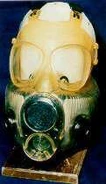Tag: Visual edit |
m (→References:) Tag: Visual edit |
||
| Line 25: | Line 25: | ||
== References: == |
== References: == |
||
# [https://www.semanticscholar.org/paper/CHEMICAL-DEFENSE-EQUIPMENT-O’HERN-Dashiell/07889ce00d201692bc171aaee1c5914d9cbc145e/figure/37 Chemical Defense Equipment, Figure 16-5] |
# [https://www.semanticscholar.org/paper/CHEMICAL-DEFENSE-EQUIPMENT-O’HERN-Dashiell/07889ce00d201692bc171aaee1c5914d9cbc145e/figure/37 Chemical Defense Equipment, Figure 16-5] |
||
| − | # [http://www.modernforces.com/uniform_gasmask.htm Modern Forces - XM28 Riot |
+ | # [http://www.modernforces.com/uniform_gasmask.htm Modern Forces - XM28 Riot Control Gas Mask] |
# [http://nofuture.com/gasmasks.net/ Le Masque à Gaz, Page USA 5] |
# [http://nofuture.com/gasmasks.net/ Le Masque à Gaz, Page USA 5] |
||
# [http://nofuture.com/gasmasks.net/database/usa5/us-200d.htm Le Masque à Gaz, DETAILS] |
# [http://nofuture.com/gasmasks.net/database/usa5/us-200d.htm Le Masque à Gaz, DETAILS] |
||
Revision as of 21:15, 15 October 2019
In 1966, the 1st Cavalry Division requested a compact and lightweight protective mask when it was found the standard ABC-M17 Field Protective Mask proved far too bulky and gave an excess of protection when dealing with Riot Control Agents deployed to flush Viet Cong from their tunnels. During trials for a lightweight protective mask, one contender used the ABC-M17 mold, however constructed of a transparent silicone rubber instead of the typical black natural/artificial rubber blend (some references state a green silicone variant was also tested). The idea was that the silicone would be lighter in weight and that the transparent material would allow soldiers to identify each other more easily.
In addition to being produced of transparent silicone rubber, the prototype also lacked lens frames and utilized a C15 Head Harness, rather than the typical C8R1. The carrier for the mask was a small, waterproofed duck canvas pouch, as the mask was not intended for use with CBR Agents and did not need a wide variety of accessories. Exact figures of production are unknown, and it did likely not last long as the XM28 Series Masks proved far more lightweight and compact.
Production of the XM28 began in 1968, and one reference hints that some remaining examples of the silicone M17's were used as training aids, as it allowed the internal workings and construction of the ABC-M17 to be fully visualized.
Additional Notes:
- The designation "XM27" is unconfirmed and was likely started by Bart Wilkus due to the design's close proximity of development with the XM28 Prototypes.
- Two examples are currently known to exist - the first (and perhaps most well-recognized) formerly belonged to Bart Wilkus of http://nofuture.com/gasmasks.net/ and is currently owned by collector Taro Hanrahan, and the second resides at the archives of the Fort Leonard Wood Chemical Warfare Museum.
- The 'amber' color of the rubber is due to aging and discoloration of the silicone. The masks would have been completely transparent originally.



